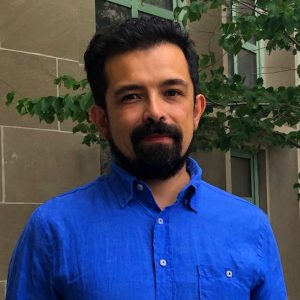Diego Loukota
I specialize on the spread of Buddhism along the Silk Road during the first millennium CE, in what spans cultural areas of South, Central, and East Asia. A philologist by training, I work with texts in the main scriptural languages of Buddhism (Sanskrit, Pāli, Chinese, Tibetan), as well as the rarer Gāndhārī and Khotanese. My research features philological treatment of unpublished and undeciphered manuscript fragments from Central Asia, but constantly in dialogue with art history, archeology, and modern ethnography. I am interested in the role of Buddhism within society and political power, its interaction with other religious traditions, and the texture of local culture and daily life in the multicultural mosaic of the Silk Road. My recent publications focus on how the Iranian, Sinitic, and Indic traditions played a role in the development of Buddhism in the oasis kingdom of Khotan. Currently I am working on a book manuscript on the life and times of the 3rd Century Gandhāran Buddhist author Kumāralāta and the crisis of the urban mercantile classes that supported Buddhism through its most dynamic phase in South Asia.
My course offerings at UCLA cover these areas and highlight the interconnection of the Asian continent through Buddhism in antiquity.
Education
UCLA, PhD, Asian Languages and Cultures — Buddhist Studies (2019). Dissertation: “The Goods that Cannot Be Stolen: Mercantile Faith in Kumāralāta’s Garland of Examples Adorned by Poetic Fancy”
Peking University (China), MA, Sanskrit and Pāli (2014). Thesis “The Anantamukhasādhanadhāraṇī: An Overview of Sanskrit, Chinese, Tibetan, and
Khotanese Versions and Parallels.”
Università di Bologna (Italy), BA, Asian Civilization and History (cum laude).
Publications
“La India filosófica explicada en la China de los Hàn,” in La tradición filosófica china en un mundo cosmopolita y multicultural: Perspectivas y análisis, edited by Filippo Costantini and Gabriel Terol, Universidad de Costa Rica. Forthcoming.
“The Vicissitudes of Supply Chain Translation: The Chinese Version of Kumāralāta’s Garland of Examples Attributed to Kumārajīva” in Diverse Voices in Chinese Translation and Interpreting: Theory and Practice, edited by Riccardo Moratto and Martin Woesler. Singapore: Springer, 2021
“Mahāyāna Sūtras in Khotan: Quotations in Chapter VI of the Book of Zambasta (II).” With Chen Ruixuan, Indo-Iranian Journal 63, (2020): 201–261.
“A New Kharoṣṭhī Document from Kucha in the Hetian County Museum Collection” in Non-Han Literature Along the Silk Road (Silk Road Studies Series 1), edited by Li Xiao. Singapore: Springer, 2020.
“Made in China? Sourcing the old Khotanese Bhaiṣajyaguruvaiḍuryaprabhasūtra.” Journal of the American Oriental Society 139.1 (2019): 67–90.
“Mahāyāna Sūtras in Khotan: Quotations in Chapter VI of the Book of Zambasta (I).” With Chen Ruixuan, Indo-Iranian Journal 61, (2018): 131-175.
“Hétián bówùguǎn-cáng yuán yú Qiūcí guó de yījiàn qūlúwén mùdú 和田博物館藏源於龜兹國的一件佉盧文木牘 [A New Kharoṣṭhī Tablet from Kucha in the Collection of the Khotan County Museum],”in 西域研究 Xiyu Yanjiu (2016): 65-74; 143.
Media appearances
March 18, 2021, interview for the Canadian Broadcasting Corporation(CBC), “Qui interviendra dans le génocide des Ouïghours?” (in French)


